An Improved Framework of Major Function-Oriented Zoning Based on Carrying Capacity: A Case Study of the Yangtze River Delta Region
Abstract
1. Introduction
2. Literature Review
2.1. Policy Development of the Major Function-Oriented Zoning
2.2. Carrying Capacity
2.3. Major Function-Oriented Zoning Based on Carrying Capacity
3. A Framework for the Major Function-Oriented Zoning Based on Carrying Capacity
4. Study Area, Method, and Data Source
4.1. Study Area
4.2. Research Methodology
4.2.1. Identifying Risk Zones for Major Functions Based on Carrying Capacity
- (1)
- Evaluating Spatial Development Suitability
- (2)
- Analyzing the current situation of carrying capacity
- (3)
- Evaluating dynamic trend of carrying capacity
- (4)
- Identifying risk zones for major functions
4.2.2. Identifying Advantageous Zones for Major Functions
4.2.3. Improving Major Function-Oriented Zoning
4.3. Data Source
5. Results
5.1. Risk Zones for Major Functions
5.1.1. Spatial Development Suitability
5.1.2. The Current Situation of Carrying Capacity
5.1.3. The Dynamic Trend of Carrying Capacity
5.1.4. The Identified Risk Zones for Major Functions
5.2. Advantageous Zones for Major Functions
5.3. The Improved Major Function-Oriented Zoning
6. Discussion
6.1. Comparison with Existing Major Function-Oriented Zone
6.2. Policy Implication
6.3. Limitations
7. Conclusions
Author Contributions
Funding
Data Availability Statement
Acknowledgments
Conflicts of Interest
References
- Lloyd, M.G. British planning: 50 years of urban and regional policy. Land Use Policy 2000, 17, 359–360. [Google Scholar] [CrossRef]
- Trkulja, S.; TošiĆ, B.; Živanović, Z. Serbian spatial planning among styles of spatial planning in Europe. Eur. Plan. Stud. 2012, 20, 1729–1746. [Google Scholar] [CrossRef]
- Hirt, S. Form follows function? How America zones. Plan. Pract. Res. 2013, 28, 204–230. [Google Scholar] [CrossRef]
- Munroe, D.K.; Croissant, C.; York, A.M. Land use policy and landscape fragmentation in an urbanizing region: Assessing the impact of zoning. Appl. Geogr. 2005, 25, 121–141. [Google Scholar] [CrossRef]
- Zhao, Y.; Leng, H.; Sun, P.; Yuan, Q. A spatial zoning model of municipal administrative areas based on major function-oriented zones. Sustainability 2018, 10, 2976. [Google Scholar] [CrossRef]
- Ye, C.; Liu, Z. Rural-urban co-governance: Multi-scale practice. Sci. Bull. 2020, 65, 778–780. [Google Scholar] [CrossRef]
- Stead, D.; Meijers, E. Spatial Planning and Policy Integration: Concepts, Facilitators and Inhibitors. Plan. Theory Pract. 2009, 10, 317–332. [Google Scholar] [CrossRef]
- Kaiser, E.J.; Godschalk, D.R.; Chapin, F.S. Urban Land Use Planning; University of Illinois Press: Champaign, IL, USA, 1995. [Google Scholar]
- Faludi, A. The European Spatial Development Perspective (ESDP) and North-West Europe: Application and Implications. Built Environ. 2000, 26, 41–52. [Google Scholar]
- Nie, X.; Lu, B.; Chen, Z.; Yang, Y.; Chen, S.; Chen, Z.; Wang, H. Increase or decrease? Integrating the clumondo and invest models to assess the impact of the implementation of the major function oriented zone planning on carbon storage. Ecol. Indic. 2020, 118, 106708. [Google Scholar] [CrossRef]
- He, J.-L.; Zong, Y.-G.; Gebhardt, H. New spatial strategy in China: Major function zoning of Beijing-Tianjin metropolitan area with perspective from ecological economics. J. Urban Plan. Dev. 2011, 137, 484–494. [Google Scholar] [CrossRef]
- Bao, S.; Lu, L.; Zhi, J.; Li, J. An optimization strategy for provincial “production–living–ecological” spaces under the guidance of major function-oriented zoning in China. Sustainability 2024, 16, 2248. [Google Scholar] [CrossRef]
- Wang, Y.; Fan, J. Multi-scale analysis of the spatial structure of China’s major function zoning. J. Geogr. Sci. 2020, 30, 197–211. [Google Scholar] [CrossRef]
- Fan, J.; Sun, W.; Zhou, K.; Chen, D. Major function-oriented zone: New method of spatial regulation for reshaping regional development pattern in China. Chin. Geogr. Sci. 2012, 22, 196–209. [Google Scholar] [CrossRef]
- Fan, J.; Sun, W.; Yang, Z.; Fan, P.; Chen, D. Focusing on the major function-oriented zone: A new spatial planning approach and practice in China and its 12th five-year plan. Asia Pac. Viewp. 2012, 53, 86–96. [Google Scholar] [CrossRef]
- Yong, Y.; Zhang, H.; Wang, X.R.; Schubert, U. Urban landuse zoning based on ecological evaluation for large conurbations in less developed regions: Case study in Foshan, China. J. Urban Plan. Dev. 2010, 136, 116–121. [Google Scholar] [CrossRef]
- Zhang, Z.; Chang, T.; Qiao, X.; Yang, Y.; Guo, J.; Zhang, H. Eco-economic coordination analysis of the yellow river basin in China: Insights from major function-oriented zoning. Sustainability 2021, 13, 2715. [Google Scholar] [CrossRef]
- Lin, Y.; Huang, F.; Zhang, Y.; Wang, Q.; Huang, J.; Chen, Q.; Xue, X. An improved framework of marine major function-oriented zoning in advancing ecosystem-based management. J. Mar. Sci. Eng. 2022, 10, 684. [Google Scholar] [CrossRef]
- Fu, H.; Liu, J.; Dong, X.; Chen, Z.; He, M. Evaluating the sustainable development goals within spatial planning for decision-making: A major function-oriented zone planning strategy in China. Land 2024, 13, 390. [Google Scholar] [CrossRef]
- Sayre, N.F. The genesis, history, and limits of carrying capacity. Ann. Assoc. Am. Geogr. 2008, 98, 120–134. [Google Scholar] [CrossRef]
- Berck, P.; Levy, A.; Chowdhury, K. An analysis of the world’s environment and population dynamics with varying carrying capacity, concerns and skepticism. Ecol. Econ. 2012, 73, 103–112. [Google Scholar] [CrossRef]
- Wang, T.; Yue, W.; Wu, T.; Zhang, X.; Xia, C. Human well-being related analysis on urban carrying capacity: An empirical study in Chinese mega-cities. J. Urban Aff. 2023, 1–17. [Google Scholar] [CrossRef]
- Chapman, E.J.; Byron, C.J. The flexible application of carrying capacity in ecology. Glob. Ecol. Conserv. 2018, 13, e00365. [Google Scholar] [CrossRef]
- Wei, Y.; Huang, C.; Lam, P.T.I.; Yuan, Z. Sustainable urban development: A review on urban carrying capacity assessment. Habitat Int. 2015, 46, 64–71. [Google Scholar] [CrossRef]
- Lane, M.; Dawes, L.; Grace, P. The essential parameters of a resource-based carrying capacity assessment model: An Australian case study. Ecol. Model. 2014, 272, 220–231. [Google Scholar] [CrossRef]
- Sevegnani, F.; Giannetti, B.F.; Agostinho, F.; Almeida, C.M.V.B. Assessment of municipal potential prosperity, carrying capacity and trade. J. Clean. Prod. 2017, 153, 425–434. [Google Scholar] [CrossRef]
- Tian, Y.; Sun, C. Comprehensive carrying capacity, economic growth and the sustainable development of urban areas: A case study of the Yangtze river economic belt. J. Clean. Prod. 2018, 195, 486–496. [Google Scholar] [CrossRef]
- Meng, C.; Du, X.; Ren, Y.; Shen, L.; Cheng, G.; Wang, J. Sustainable urban development: An examination of literature evolution on urban carrying capacity in the Chinese context. J. Clean. Prod. 2020, 277, 122802. [Google Scholar] [CrossRef]
- Santoso, E.B.; Erli, H.K.D.M.; Aulia, B.U.; Ghozali, A. Concept of carrying capacity: Challenges in spatial planning (case study of east java province, Indonesia). Procedia-Soc. Behav. Sci. 2014, 135, 130–135. [Google Scholar] [CrossRef]
- Mote, S.; Rivas, J.; Kalnay, E. A novel approach to carrying capacity: From a priori prescription toa posteriori derivation based on underlying mechanisms and dynamics. Annu. Rev. Earth Planet. Sci. 2020, 48, 657–683. [Google Scholar] [CrossRef]
- Liu, H. Comprehensive carrying capacity of the urban agglomeration in the Yangtze river delta, China. Habitat Int. 2012, 36, 462–470. [Google Scholar] [CrossRef]
- Liu, W.; Liu, J.; Kuang, W.; Ning, J. Examining the influence of the implementation of major function-oriented zones on built-up area expansion in China. J. Geogr. Sci. 2017, 27, 643–660. [Google Scholar] [CrossRef]
- Daily, G.; Ehrlich, P. Nature’s Services: Societal Dependence on Natural Ecosystems; Island Press: Washington, DC, USA, 1997. [Google Scholar]
- Hsu, W.L.; Shen, X.J.; Xu, H.Y.; Zhang, C.M.; Liu, H.-L.; Shiau, Y.-C. Integrated evaluations of resource and environment carrying capacity of the Huaihe river ecological and economic belt in China. Land 2021, 10, 1168. [Google Scholar] [CrossRef]
- Arrow, K.; Bolin, B.; Costanza, R.; Dasgupta, P.; Folke, C.; Holling, C.S.; Jansson, B.O.; Levin, S.; Mäler, K.G.; Perrings, C.; et al. Economic growth, carrying capacity, and the environment. Ecol. Econ. 1995, 15, 91–95. [Google Scholar] [CrossRef]
- Rees, W.E. Ecological footprints and appropriated carrying capacity: What urban economics leaves out? Environ. Urban. 1992, 4, 121–130. [Google Scholar] [CrossRef]
- Daily, G.C.; Ehrlich, P.R. Socioeconomic equity, sustainability, and earth’s carrying capacity. Ecol. Appl. 1996, 6, 991–1001. [Google Scholar] [CrossRef]
- Wang, T.; Xu, S. Dynamic successive assessment method of water environment carrying capacity and its application. Ecol. Indic. 2015, 52, 134–146. [Google Scholar] [CrossRef]
- Wei, Y.; Huang, C.; Li, J.; Xie, L. An evaluation model for urban carrying capacity: A case study of China’s mega-cities. Habitat Int. 2016, 53, 87–96. [Google Scholar] [CrossRef]
- Lane, M. The carrying capacity imperative: Assessing regional carrying capacity methodologies for sustainable land-use planning. Land Use Policy 2010, 27, 1038–1045. [Google Scholar] [CrossRef]
- Li, X.; Cundy, A.B.; Chen, W.P.; Li, R.; Lv, S.D. Dynamic capacity modelling of soil environment carrying capacity, and developing a soil quality early warning framework for development land in China. J. Clean. Prod. 2020, 257, 120450. [Google Scholar] [CrossRef]
- Han, C.; Lu, B.; Zheng, J. Analysis and prediction of land resources carrying capacity in 31 provinces of China from 2008 to 2016. Sustainability 2021, 13, 13383. [Google Scholar] [CrossRef]
- Kapoor, N.; Bansal, V.K. Spatial suitability assessment for planning infrastructure facilities at site level in hill areas. J. Urban Manag. 2021, 10, 27–45. [Google Scholar] [CrossRef]
- Zhu, G.; Zhao, P.; Zhang, L.; Li, X.; Ding, W.; Yu, H.; Zhang, N.; Yang, S.; Zhang, C.; Xie, Z. Territorial spatial suitability assessment and optimization of coastal port reclamation in China. Ocean Coast. Manag. 2024, 254, 107189. [Google Scholar] [CrossRef]
- Kuller, M.; Bach, P.M.; Roberts, S.; Browne, D.; Deletic, A. A planning-support tool for spatial suitability assessment of green urban stormwater infrastructure. Sci. Total Environ. 2019, 686, 856–868. [Google Scholar] [CrossRef] [PubMed]
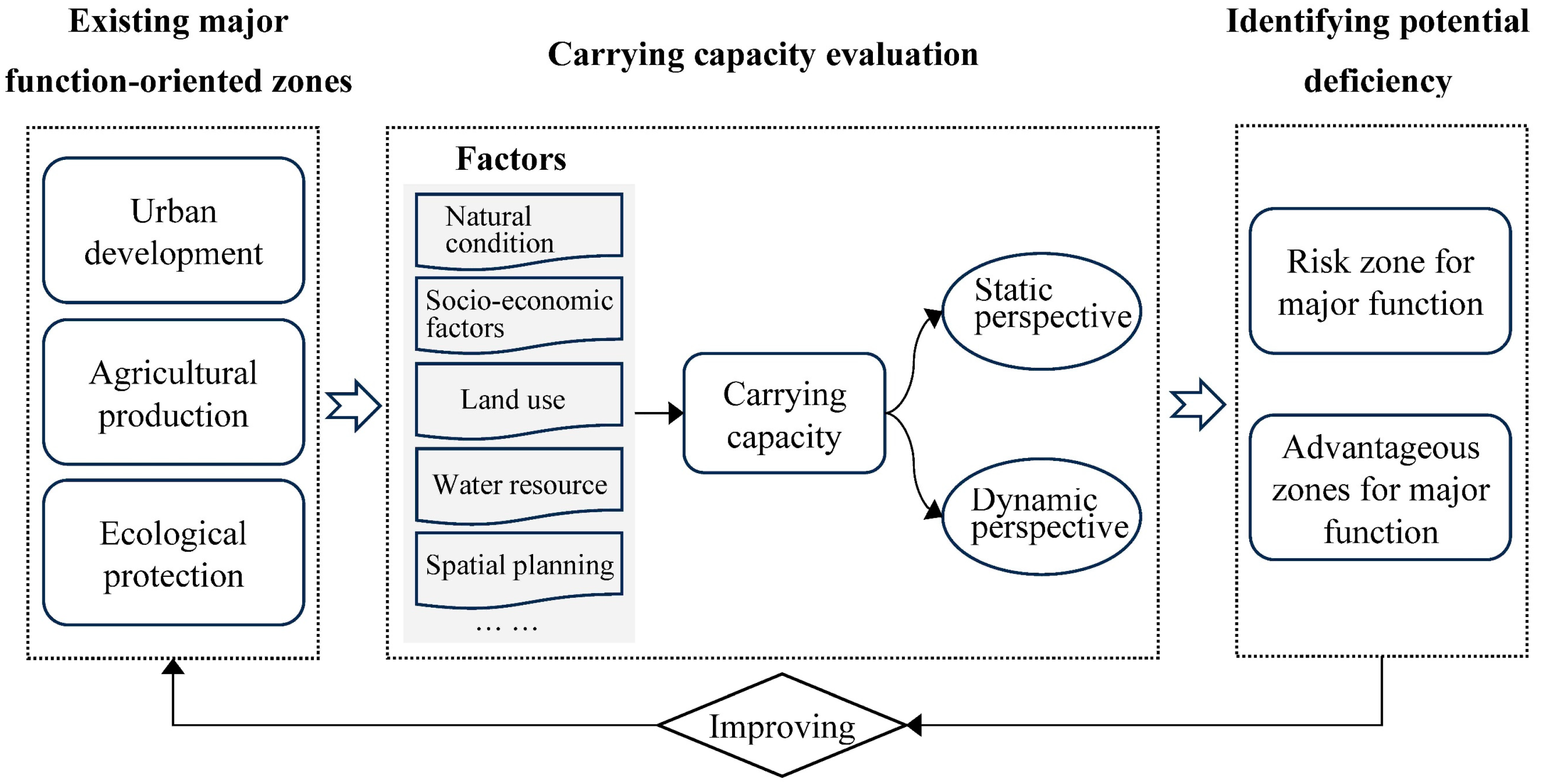

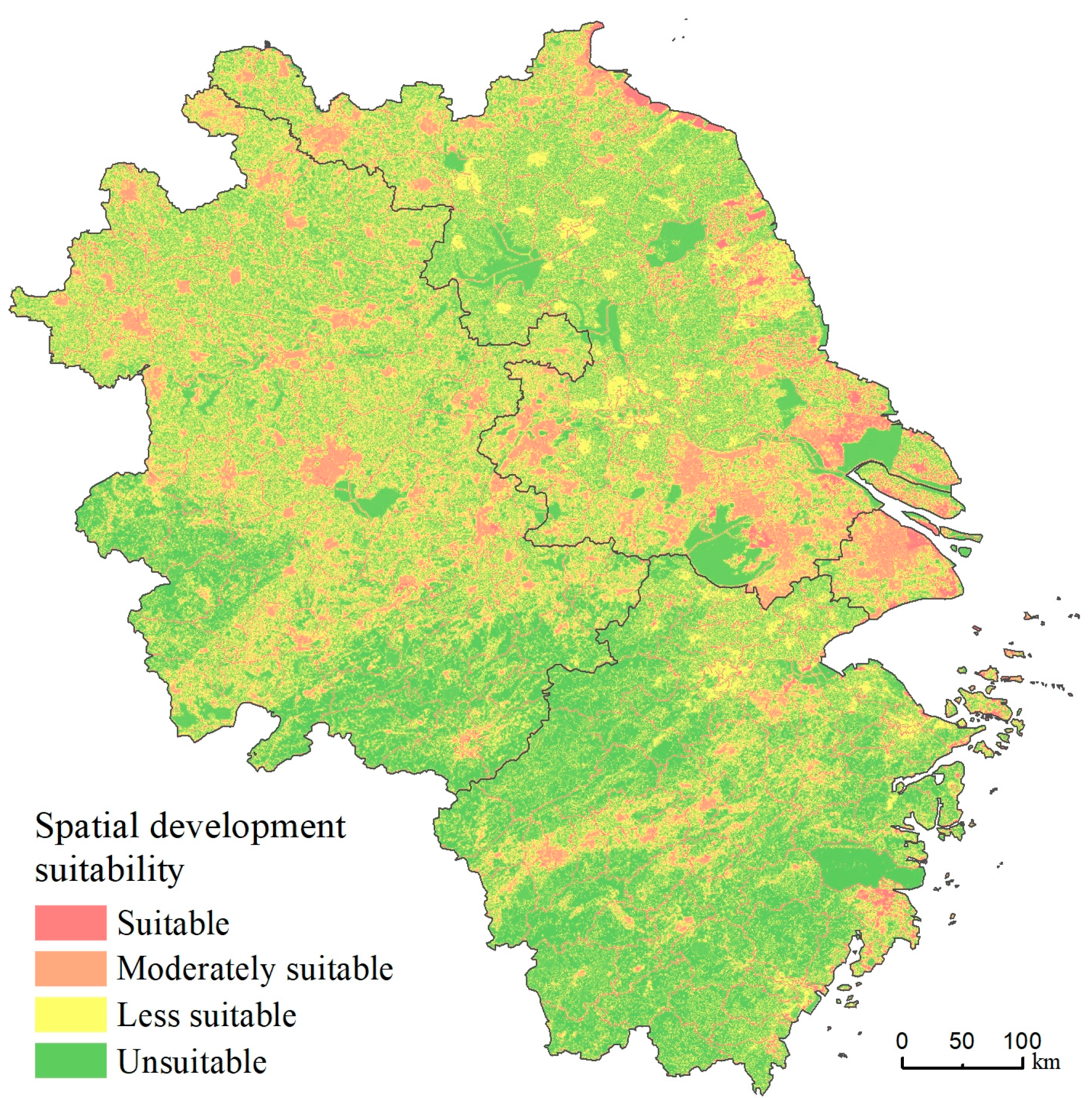

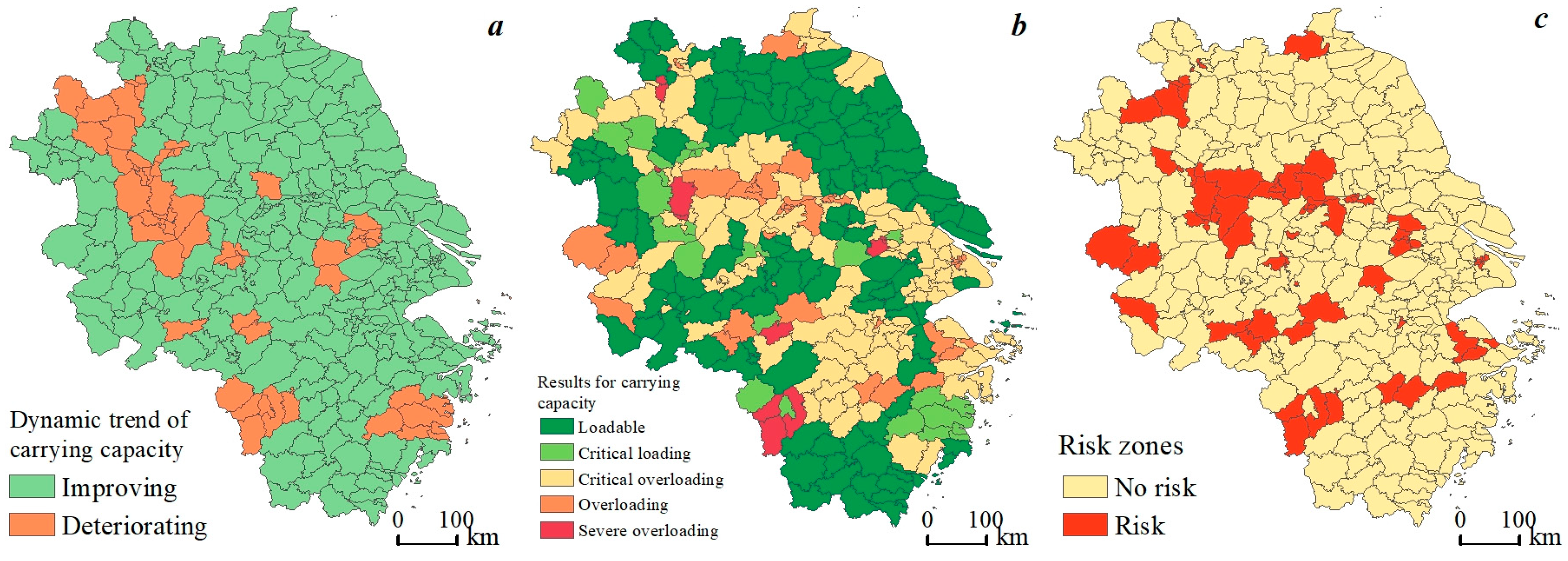
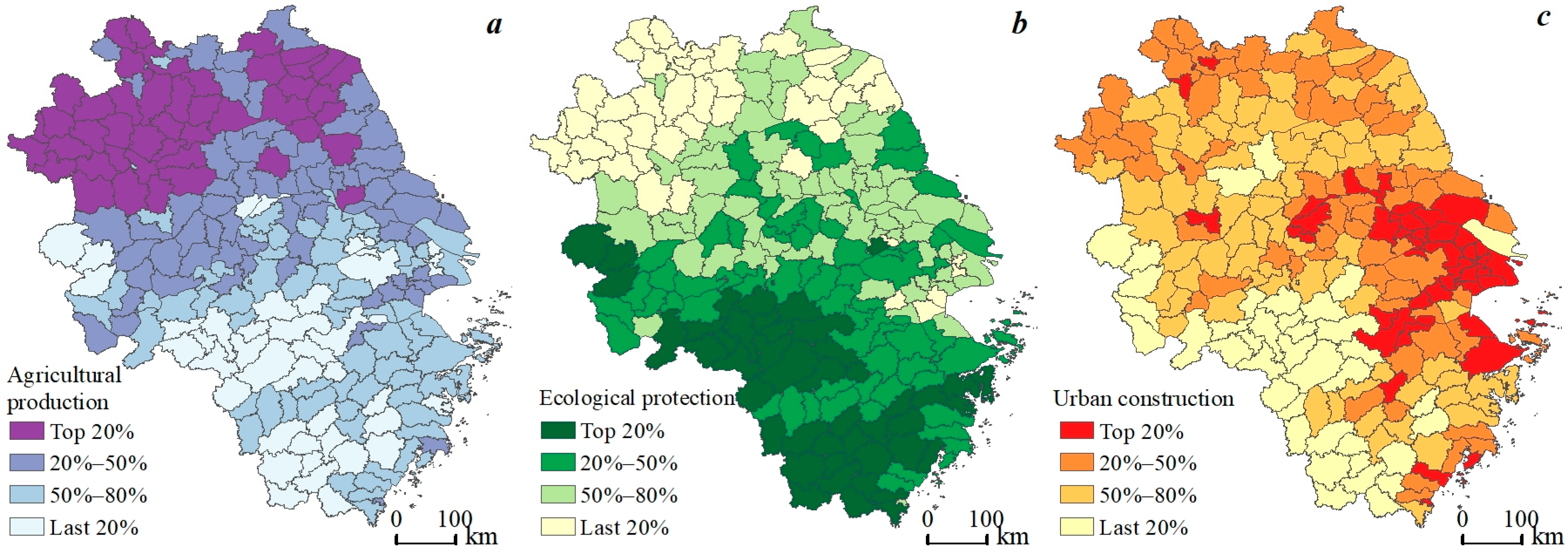
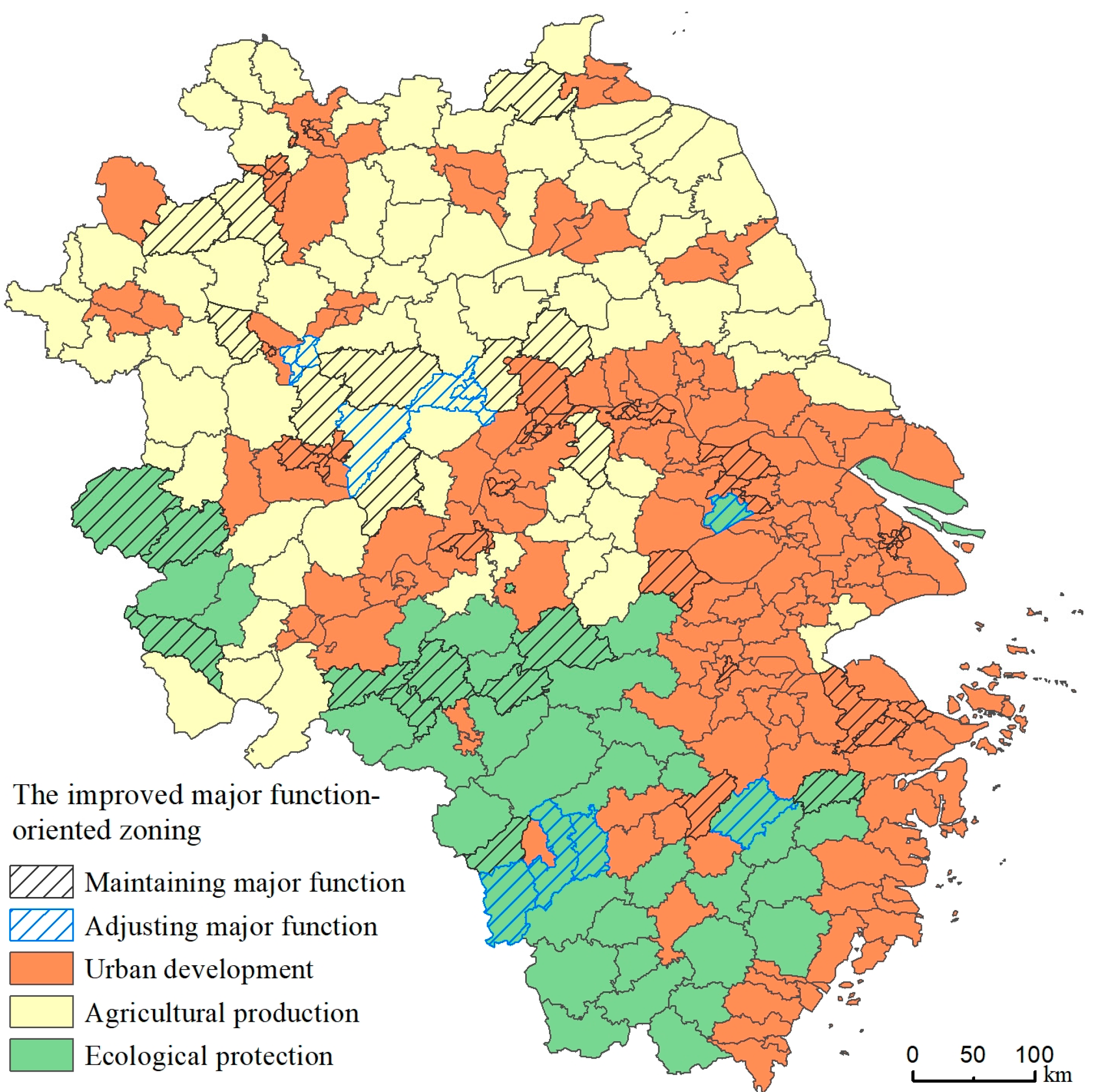
| Dimension | Indicator | Grade | Suitability Level |
|---|---|---|---|
| Natural condition | Slope | 0°–8° | Suitable |
| 8°–25° | Moderately suitable | ||
| >25° | Less suitable | ||
| Topographic relief | ≤100 m | Suitable | |
| 100–200 m | Suitable | ||
| >200 m | Less suitable | ||
| Land resource | Ecological land | Non-ecological land | Suitable |
| Other ecological land | Moderately suitable | ||
| Public forests, artificial grasslands | Less suitable | ||
| River and lake wetlands | Unsuitable | ||
| Cultivated land | Non-cultivated land | suitable | |
| 6~8 grade arable land | Moderately suitable | ||
| 4~5 grade arable land | Less suitable | ||
| Water resource | Water resource modulus | >200,000 m3/km2 | Suitable |
| 50,000–200,000 m3/km2 | Moderately suitable | ||
| ≤50,000 m3/km2 | Less suitable | ||
| Planning strategy | Ecological protection redline | No | Suitable |
| Ecological protection red line | Unsuitable | ||
| Permanent basic farmland | No | Suitable | |
| Permanent basic farmland | Unsuitable | ||
| Geologic environment | Ground subsidence | General, slight or stable area | Suitable |
| More serious subsidence area | Moderately suitable | ||
| Severe subsidence areas | Less suitable | ||
| Active faults | Stable, slight or more seriously affected areas | Suitable | |
| more seriously affected areas | Moderately suitable | ||
| Mine occupied land | Non-occupied land | Suitable | |
| Transit sites, mine buildings | Moderately suitable | ||
| Landslides | Less suitable | ||
| Landslides Mudslides | Not easily prone areas | Suitable | |
| Medium and low susceptibility areas | Moderately suitable | ||
| Highly susceptible area | Less suitable | ||
| Karst collapse Medium | Medium, low, not prone area | Suitable | |
| High susceptibility zone | Moderately suitable |
| Dimension | Indicator | Weight |
|---|---|---|
| Land resource | Built-up land | 0.3 |
| Cultivated land area | 0.2 | |
| Ecological land | 0.2 | |
| Water resource | Total water resource | 0.1 |
| Total water use | 0.1 | |
| Environmental Quality | Water pollutant emission (Ammonia Nitrogen) (L6) | 0.05 |
| Air pollutant emissions (NOx) | 0.05 |
| Pressure | Dynamic Trend | Carrying Capacity | Risk for Major Function |
|---|---|---|---|
| High pressure | − | Severe overloading | Risk |
| + | Overloading | Risk | |
| Medium pressure | − | Critical overloading | Risk |
| + | Critical overloading | No risk | |
| Less pressure | − | Critical loading | No risk |
| + | Loadable | No risk |
| Major Functions | Indicators |
|---|---|
| Ecological protection | Percentage of ecological land area |
| Percentage of ecological redline area | |
| Agricultural production | Percentage of farmland area |
| Total grain output | |
| Urban development | Percentage of built-up land |
| Urbanization rate | |
| GDP per unit of land |
| Risk Zone | Ranking for Major Functions | ||
|---|---|---|---|
| Agriculture ≥ Ecology, Urbanization | Ecology ≥ Agriculture, Urbanization | Urbanization ≥ Ecology, Agriculture | |
| Agricultural production | Maintaining existing function, strengthening farmland protection | Adjusting to ecological protection | Adjusting to urban development |
| Ecological protection | Adjusting to agricultural production | Maintaining existing functional, strengthening ecological protection | Adjusting to urban development |
| Urban development | Adjusting to agricultural production | Adjusting to ecological protection | Maintaining existing function, strengthening land–human regulation |
| Existing Functional Zone | Optimized Suggestion (Total Number) | County Name | Regulation Strategy |
|---|---|---|---|
| Urban development | Adjusting to agricultural production (5) | Da Tong District, Fei Dong County, etc. | / |
| Adjusting to ecological protection (2) | Binhu District, Dongyang City, etc. | / | |
| Maintaining the existing functional zones (36) | Hongkou District, Huangpu District, etc. | Regulating the built-up land, improving the efficiency and intensity of existing land use | |
| Jingkou District, Luhe District, etc. | Leading land development towards suitable goals, regulating the total number of built-up land, and improving the efficiency and intensity of existing land use | ||
| Agricultural production | Adjusting to ecological protection (3) | Jiangshan City, Longyou County etc. | / |
| Maintaining the existing functional zone (10) | Donghai County, Jurong City, etc. | Leading land development towards suitable goals and strengthening the protection of the quantity and quality of arable land | |
| Suixi County, Guoyang County | Controlling development intensity and strengthening the protection of the quantity and quality of arable land | ||
| Ecological protection | Maintaining the existing functional zone (10) | Changshan County, Xinchang County, etc. | Leading land development towards suitable goals, strengthening ecological protection, and improving the efficiency of land and water resources usage |
Disclaimer/Publisher’s Note: The statements, opinions and data contained in all publications are solely those of the individual author(s) and contributor(s) and not of MDPI and/or the editor(s). MDPI and/or the editor(s) disclaim responsibility for any injury to people or property resulting from any ideas, methods, instructions or products referred to in the content. |
© 2024 by the authors. Licensee MDPI, Basel, Switzerland. This article is an open access article distributed under the terms and conditions of the Creative Commons Attribution (CC BY) license (https://creativecommons.org/licenses/by/4.0/).
Share and Cite
Zhang, Q.; Wang, L.; Wang, H.; Chen, Y.; Tian, C.; Shao, Y.; Liu, T. An Improved Framework of Major Function-Oriented Zoning Based on Carrying Capacity: A Case Study of the Yangtze River Delta Region. Land 2024, 13, 1732. https://doi.org/10.3390/land13111732
Zhang Q, Wang L, Wang H, Chen Y, Tian C, Shao Y, Liu T. An Improved Framework of Major Function-Oriented Zoning Based on Carrying Capacity: A Case Study of the Yangtze River Delta Region. Land. 2024; 13(11):1732. https://doi.org/10.3390/land13111732
Chicago/Turabian StyleZhang, Qun, Lili Wang, Hanmei Wang, Yang Chen, Chunhua Tian, Yixi Shao, and Tiange Liu. 2024. "An Improved Framework of Major Function-Oriented Zoning Based on Carrying Capacity: A Case Study of the Yangtze River Delta Region" Land 13, no. 11: 1732. https://doi.org/10.3390/land13111732
APA StyleZhang, Q., Wang, L., Wang, H., Chen, Y., Tian, C., Shao, Y., & Liu, T. (2024). An Improved Framework of Major Function-Oriented Zoning Based on Carrying Capacity: A Case Study of the Yangtze River Delta Region. Land, 13(11), 1732. https://doi.org/10.3390/land13111732










